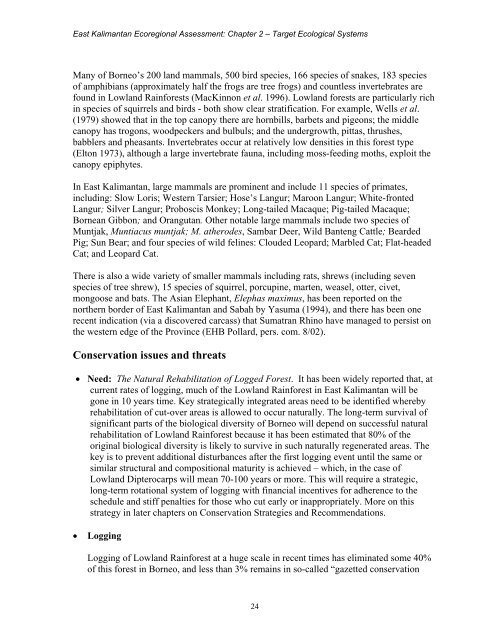Ecoregional Assessment of Biological Diversity in East Kalimantan
Ecoregional Assessment of Biological Diversity in East Kalimantan
Ecoregional Assessment of Biological Diversity in East Kalimantan
You also want an ePaper? Increase the reach of your titles
YUMPU automatically turns print PDFs into web optimized ePapers that Google loves.
<strong>East</strong> <strong>Kalimantan</strong> <strong>Ecoregional</strong> <strong>Assessment</strong>: Chapter 2 – Target Ecological Systems<br />
Many <strong>of</strong> Borneo’s 200 land mammals, 500 bird species, 166 species <strong>of</strong> snakes, 183 species<br />
<strong>of</strong> amphibians (approximately half the frogs are tree frogs) and countless <strong>in</strong>vertebrates are<br />
found <strong>in</strong> Lowland Ra<strong>in</strong>forests (MacK<strong>in</strong>non et al. 1996). Lowland forests are particularly rich<br />
<strong>in</strong> species <strong>of</strong> squirrels and birds - both show clear stratification. For example, Wells et al.<br />
(1979) showed that <strong>in</strong> the top canopy there are hornbills, barbets and pigeons; the middle<br />
canopy has trogons, woodpeckers and bulbuls; and the undergrowth, pittas, thrushes,<br />
babblers and pheasants. Invertebrates occur at relatively low densities <strong>in</strong> this forest type<br />
(Elton 1973), although a large <strong>in</strong>vertebrate fauna, <strong>in</strong>clud<strong>in</strong>g moss-feed<strong>in</strong>g moths, exploit the<br />
canopy epiphytes.<br />
In <strong>East</strong> <strong>Kalimantan</strong>, large mammals are prom<strong>in</strong>ent and <strong>in</strong>clude 11 species <strong>of</strong> primates,<br />
<strong>in</strong>clud<strong>in</strong>g: Slow Loris; Western Tarsier; Hose’s Langur; Maroon Langur; White-fronted<br />
Langur; Silver Langur; Proboscis Monkey; Long-tailed Macaque; Pig-tailed Macaque;<br />
Bornean Gibbon; and Orangutan. Other notable large mammals <strong>in</strong>clude two species <strong>of</strong><br />
Muntjak, Muntiacus muntjak; M. atherodes, Sambar Deer, Wild Banteng Cattle; Bearded<br />
Pig; Sun Bear; and four species <strong>of</strong> wild fel<strong>in</strong>es: Clouded Leopard; Marbled Cat; Flat-headed<br />
Cat; and Leopard Cat.<br />
There is also a wide variety <strong>of</strong> smaller mammals <strong>in</strong>clud<strong>in</strong>g rats, shrews (<strong>in</strong>clud<strong>in</strong>g seven<br />
species <strong>of</strong> tree shrew), 15 species <strong>of</strong> squirrel, porcup<strong>in</strong>e, marten, weasel, otter, civet,<br />
mongoose and bats. The Asian Elephant, Elephas maximus, has been reported on the<br />
northern border <strong>of</strong> <strong>East</strong> <strong>Kalimantan</strong> and Sabah by Yasuma (1994), and there has been one<br />
recent <strong>in</strong>dication (via a discovered carcass) that Sumatran Rh<strong>in</strong>o have managed to persist on<br />
the western edge <strong>of</strong> the Prov<strong>in</strong>ce (EHB Pollard, pers. com. 8/02).<br />
Conservation issues and threats<br />
• Need: The Natural Rehabilitation <strong>of</strong> Logged Forest. It has been widely reported that, at<br />
current rates <strong>of</strong> logg<strong>in</strong>g, much <strong>of</strong> the Lowland Ra<strong>in</strong>forest <strong>in</strong> <strong>East</strong> <strong>Kalimantan</strong> will be<br />
gone <strong>in</strong> 10 years time. Key strategically <strong>in</strong>tegrated areas need to be identified whereby<br />
rehabilitation <strong>of</strong> cut-over areas is allowed to occur naturally. The long-term survival <strong>of</strong><br />
significant parts <strong>of</strong> the biological diversity <strong>of</strong> Borneo will depend on successful natural<br />
rehabilitation <strong>of</strong> Lowland Ra<strong>in</strong>forest because it has been estimated that 80% <strong>of</strong> the<br />
orig<strong>in</strong>al biological diversity is likely to survive <strong>in</strong> such naturally regenerated areas. The<br />
key is to prevent additional disturbances after the first logg<strong>in</strong>g event until the same or<br />
similar structural and compositional maturity is achieved – which, <strong>in</strong> the case <strong>of</strong><br />
Lowland Dipterocarps will mean 70-100 years or more. This will require a strategic,<br />
long-term rotational system <strong>of</strong> logg<strong>in</strong>g with f<strong>in</strong>ancial <strong>in</strong>centives for adherence to the<br />
schedule and stiff penalties for those who cut early or <strong>in</strong>appropriately. More on this<br />
strategy <strong>in</strong> later chapters on Conservation Strategies and Recommendations.<br />
• Logg<strong>in</strong>g<br />
Logg<strong>in</strong>g <strong>of</strong> Lowland Ra<strong>in</strong>forest at a huge scale <strong>in</strong> recent times has elim<strong>in</strong>ated some 40%<br />
<strong>of</strong> this forest <strong>in</strong> Borneo, and less than 3% rema<strong>in</strong>s <strong>in</strong> so-called “gazetted conservation<br />
24

















